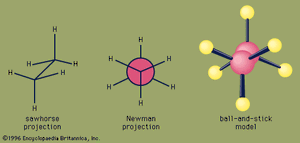ethane
- Related Topics:
- paraffin hydrocarbon
ethane, a colourless, odourless, gaseous hydrocarbon (compound of hydrogen and carbon), belonging to the paraffin series; its chemical formula is C2H6. Ethane is structurally the simplest hydrocarbon that contains a single carbon–carbon bond. The second most important constituent of natural gas, it also occurs dissolved in petroleum oils and as a by-product of oil refinery operations and of the carbonization of coal.
The industrial importance of ethane is based upon the ease with which it may be converted to ethylene (C2H4) and hydrogen by pyrolysis, or cracking, when passed through hot tubes. Like propane and, to a lesser extent, butane, ethane is a major raw material for the huge ethylene petrochemical industry, which produces such important products as polyethylene plastic, ethylene glycol, and ethyl alcohol.
More than 90 percent of the ethane produced in the 1960s was burned as fuel without separation from natural gas. Ethane gas can be liquefied under pressure or at reduced temperatures and thus be separated from natural gas. Unlike propane, liquid ethane is not in common use as an industrial or domestic fuel.














